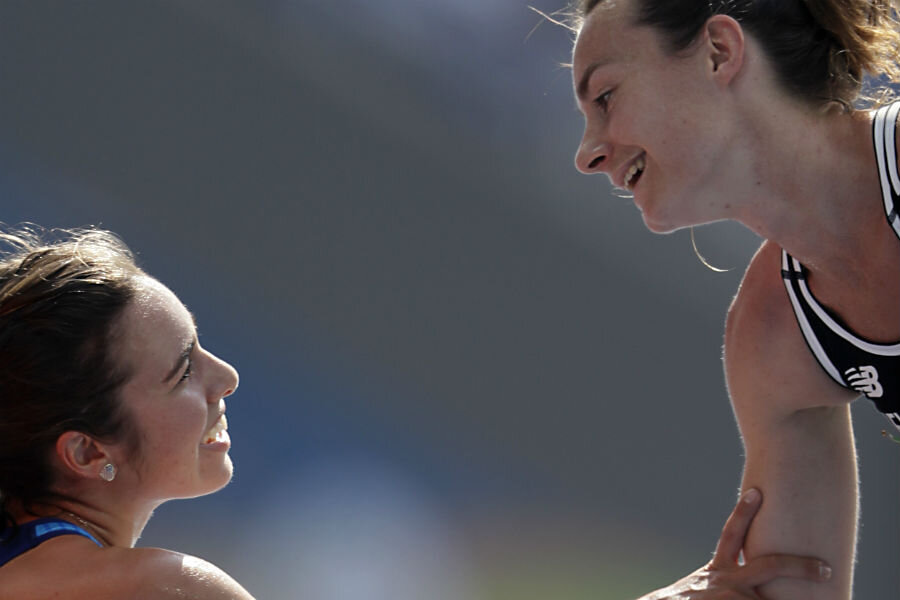After stumbles in 5,000m, two Olympians exhibit hearts of gold
| Rio de Janeiro
New Zealand runner Nikki Hamblin was lying on the track, dazed after a heavy fall and with her hopes of an Olympic medal seemingly over. Suddenly, there was a hand on her shoulder and a voice in her ear: "Get up. We have to finish this."
It was American Abbey D'Agostino, offering to help.
"I was like, "Yup, yup, you're right. This is the Olympics Games. We have to finish this,'" Hamblin said.
It was a scene to warm the hearts of fans during a qualifying heat of the women's 5,000 meters. Hamblin and D'Agostino set aside their own hopes of making the final to look out for a fellow competitor.
It started when D'Agostino clipped Hamblin from behind and they both went sprawling with about 2,000 meters to go.
Hamblin fell heavily on her right shoulder. D'Agostino got up, but Hamblin was just lying there. She appeared to be crying. Instead of running in pursuit of the others, D'Agostino crouched down and put her hand on the New Zealander's shoulder, then under her arms to help her up, and softly urged her not to quit.
"That girl is the Olympic spirit right there," Hamblin said of D'Agostino. "I've never met her before. Like I never met this girl before. And isn't that just so amazing. Such an amazing woman."
As it turned out, D'Agostino probably needed more help: She soon realized she'd hurt her ankle in the fall.
Grimacing, she refused to give up, though, running nearly half the race with the injury. Hamblin did what she could, hanging back with D'Agostino for a little while to return the favor and offer encouragement.
"She helped me first. I tried to help her. She was pretty bad," Hamblin said. She eventually had to leave D'Agostino behind and was certain that the American would have to stop.
Nope.
"I didn't even realize she was still running. When I turned around at the finish line and she's still running, I was like, wow," Hamblin said.
She waited for her new friend to cross the line — D'Agostino had been lapped — and they hugged.
This time, it was D'Agostino who was in tears.
As D'Agostino was about to be taken away in a wheelchair, she stretched out her right hand and the two runners gripped each other's forearms for a few moments.
The Rio Olympics that has seen a few unsavory incidents: For example, Islam El Shehaby, the Egyptian judoka, refused to shake hands with his Israeli opponent, as The Christian Science Monitor reported.
The crowd booed Mr. El Shehaby, the International Olympic Committee (IOC) reprimanded him, and his team has sent him home.
On its surface, El Shehaby’s poor sportsmanship is another instance of an Arab athlete’s refusal to compete against an Israeli at the Olympics and other international competitions, or follow normal protocol with Israeli opponents. Yet, El Shehaby’s actions also expose a recurring question of whether athletes from any country can serve as ambassadors without bringing nationalism with them to the mat, field, or pool.
"As soon as you have athletes walk under a national flag, you make them representative of a nation state. As soon as you do that, you bring in all that political strife," John Gleaves, a professor at California State University, Fullerton, and member of the Center for Sociocultural Sport and Olympic Research there, tells The Christian Science Monitor in a phone interview.
But Hamblin and D'Agostino provided a memory that captured the Olympic spirit.
Olympic officials also decided that both runners, and Austria's Jennifer Wenth, who was also affected by the collision, would have places in Friday's final.
"I'm never going to forget that moment," Hamblin said. "When someone asks me what happened in Rio in 20 years' time, that's my story ... That girl shaking my shoulder, (saying) 'come on, get up'."






